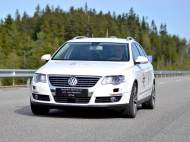HAVEit project provides different levels of automated driving
 The EU funded R&D project named Highly Automated Vehicles for Intelligent Transport (HAVEit) is set to develop research concepts and technologies for highly automated driving. The system would enable drivers to choose if they would like to take over driving responsibilities, merely receive “assistance” from the vehicle, or if they would like the vehicle to run at a semi-automated or even highly-automated level.
The EU funded R&D project named Highly Automated Vehicles for Intelligent Transport (HAVEit) is set to develop research concepts and technologies for highly automated driving. The system would enable drivers to choose if they would like to take over driving responsibilities, merely receive “assistance” from the vehicle, or if they would like the vehicle to run at a semi-automated or even highly-automated level.
The FASCar II demonstration vehicle consists of a multitude of components from various HAVEit project partners. Along with its own steer-by-wire system, the German Aerospace Center integrated a host of features into the Volkswagen Passat, including the SICK laser scanner, Car2Car communication from the Institut National de Recherche en Informatique et en Automatique (INRIA), the Chassis & Safety Controller (ECU) from Continental and XCC controlling hardware for the steer-by-wire system from the University of Stuttgart’s Institute of Aeronautical Systems.
“Whereas the steering wheel in today’s vehicles moves according to steering motions, the steering wheel in the FASCar II can remain motionless during automated driving, or support the driver with suggestions during normal driving”, said Prof. Karsten Lemmer, Director of the DLR Institute of Transportation Systems. “The vehicle can give the driver perceptible, tactile feedback, for example through vibrations, counter-steering or jerking, while the steering shaft can be controlled entirely independently of these signals.”
The interaction between driver and highly-automated vehicle is possible due to sensors which detect the environment around the car and a detailed positioning system, which detects obstacles, objects and the driving lane with precision, as well as the cutting edge steer-by-wire technology. In place of a mechanized steering rod, which links the steering wheel to the steering shaft, the steering input is transferred electronically (“by wire”).
At the “assisted” level, drivers will only receive support, for example receiving a tactile warning through the steering wheel that they are about to exit a driving lane, though they will need to steer the vehicle on their own. At the “semi-automated level”, the vehicle will take over certain driving tasks, although drivers are still able to take control of the vehicle at any time. During semi-automated driving the system takes over the functions of intelligent ACC (Adaptive Cruise Control), which automatically sets the vehicle to drive at the desired speed or to stay at a certain distance behind a slower vehicle. At the “highly-automated” level, the vehicle can be driven with no hands on the steering wheel (hands off driving), as speed, distance adjustment, lane driving and overtaking are set and carried out automatically. Drivers can decide for themselves how many of the driving tasks they would like to leave up to the automation and can take control again at any time.
The DLR developed the human-machine interface, tactile feedback, automation level selection, the FASCar II basic controller and the steer-by-wire system. The co-pilot maneuver generation system resulted from cooperation with the Institut français des sciences et technologies des transports, de l’aménagement et des réseaux (IFSTTAR), which also developed the trajectory tracking controller. Software integrated into the vehicle includes data fusion software from the University of Athens Institute of Communications and Computer Systems (ICCS), co-pilot trajectory generation from the Institut National de Recherche en Informatique et en Automatique (INRIA) and the driver condition recognition system from the Würzburg Institute for Traffic Sciences GmbH.
The features of the semi-automated and highly-automated levels which allow the car to automatically stay at the speed limit, prevent passing on the right, and emergency braking when needed are also being integrated. The automation enables the vehicle to follow the vehicle ahead at a safe distance, speeding up to the pre-set speed as soon as the slower vehicle ahead accelerates into the left lane and drives on. If there is a speed limit, the system receives this information through Car2Infrastructure communication (C2X) and the vehicle automatically adjusts its speed.
“In view of increasing traffic density, the growing flood of information available to drivers and the rising average age of the population, highly automated vehicles will characterize the future of mobility. Automation will relieve drivers of some of the stress of driving as it guides them through traffic more efficiently, using more environmentally friendly technology”, said Dr. Reiner Hoeger, HAVEit project coordinator.









Leave your response!